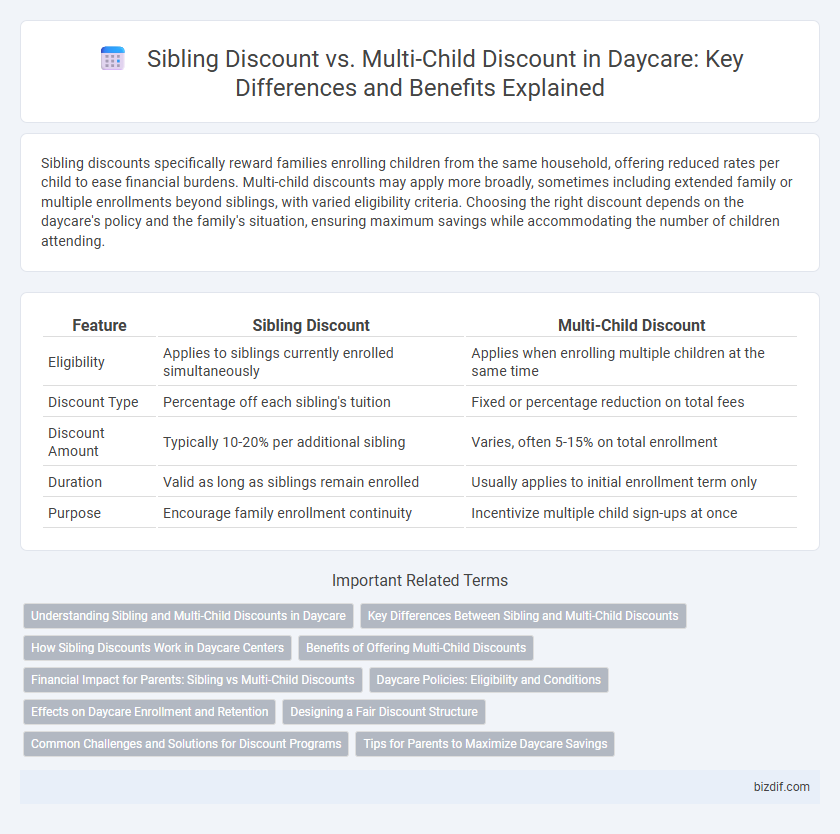Sibling discounts specifically reward families enrolling children from the same household, offering reduced rates per child to ease financial burdens. Multi-child discounts may apply more broadly, sometimes including extended family or multiple enrollments beyond siblings, with varied eligibility criteria. Choosing the right discount depends on the daycare's policy and the family's situation, ensuring maximum savings while accommodating the number of children attending.
Table of Comparison
| Feature | Sibling Discount | Multi-Child Discount |
|---|---|---|
| Eligibility | Applies to siblings currently enrolled simultaneously | Applies when enrolling multiple children at the same time |
| Discount Type | Percentage off each sibling's tuition | Fixed or percentage reduction on total fees |
| Discount Amount | Typically 10-20% per additional sibling | Varies, often 5-15% on total enrollment |
| Duration | Valid as long as siblings remain enrolled | Usually applies to initial enrollment term only |
| Purpose | Encourage family enrollment continuity | Incentivize multiple child sign-ups at once |
Understanding Sibling and Multi-Child Discounts in Daycare
Sibling discounts in daycare typically apply when two or more children from the same family enroll individually, offering a reduced rate on each additional sibling's tuition. Multi-child discounts often refer to a broader pricing strategy that may bundle care costs for several children simultaneously, potentially including twins or triplets, providing a cumulative cost advantage. Understanding these distinctions helps parents optimize childcare expenses by selecting the most beneficial discount structure based on the number and enrollment status of their children.
Key Differences Between Sibling and Multi-Child Discounts
Sibling discounts typically apply when two or more children from the same family attend the same daycare, offering a percentage off tuition per additional child enrolled. Multi-child discounts often encompass families with multiple children enrolled across different programs or age groups, providing broader financial relief beyond just immediate siblings. While both aim to reduce costs, sibling discounts are specific to hierarchical family relationships, whereas multi-child discounts address overall enrollment volume.
How Sibling Discounts Work in Daycare Centers
Sibling discounts in daycare centers typically apply when two or more children from the same family are enrolled, offering reduced tuition rates to ease the financial burden on parents. These discounts often range from 10% to 25% off the regular price for the second and subsequent children, encouraging families to utilize the same facility for all their kids. Daycare providers implement this pricing strategy to retain clients and reward families, making quality childcare more affordable for multiple siblings.
Benefits of Offering Multi-Child Discounts
Offering multi-child discounts in daycare centers encourages family enrollment by reducing the overall cost for parents with more than one child, making quality childcare more affordable. These discounts promote long-term client retention and foster a positive community reputation, as families appreciate the financial relief and value-driven service. Multi-child discounts also streamline administrative processes by consolidating billing and communication under a single account, enhancing operational efficiency for daycare providers.
Financial Impact for Parents: Sibling vs Multi-Child Discounts
Sibling discounts in daycare programs typically offer a percentage reduction on the second child's tuition, providing immediate financial relief for families enrolling multiple children. Multi-child discounts often extend savings beyond just two children, applying scaled reductions that can significantly decrease total childcare expenses for larger families. Evaluating these options enables parents to optimize childcare costs based on family size, maximizing budget efficiency without compromising care quality.
Daycare Policies: Eligibility and Conditions
Daycare policies on sibling discounts typically apply when two or more children from the same family are enrolled simultaneously, offering reduced rates based on the number of siblings attending. Multi-child discounts may extend beyond siblings to include relatives or multiple children under the same guardian, with specific eligibility criteria such as age groups or enrollment status. Conditions often require proof of relationship, simultaneous enrollment, and may limit discounts to particular programs or service durations.
Effects on Daycare Enrollment and Retention
Sibling discounts and multi-child discounts significantly impact daycare enrollment by making it more affordable for families with multiple children, thereby increasing the likelihood of continuous enrollment. These discounts enhance retention rates as parents perceive greater value and financial ease, encouraging long-term commitment to the daycare center. Offering such cost-saving incentives strengthens family loyalty and promotes stable enrollment numbers over time.
Designing a Fair Discount Structure
Designing a fair discount structure in daycare requires clear differentiation between sibling and multi-child discounts to ensure equitable financial benefits for families. Sibling discounts typically apply when two or more children from the same family attend the daycare simultaneously, offering a percentage off the tuition of the second child and any subsequent children. Multi-child discounts can extend beyond immediate siblings, potentially including cousins or extended family members, and should be structured with transparent eligibility criteria to balance affordability with operational sustainability.
Common Challenges and Solutions for Discount Programs
Sibling discount and multi-child discount programs in daycare often face challenges such as eligibility confusion and inconsistent application across families. Clear documentation of family enrollment and transparent communication about discount criteria can mitigate misunderstandings and ensure fairness. Implementing standardized software systems helps automate discount calculations, reducing administrative errors and improving overall program efficiency.
Tips for Parents to Maximize Daycare Savings
Parents can maximize daycare savings by understanding the difference between sibling discounts and multi-child discounts, as many centers offer reduced rates for families enrolling more than one child. Sibling discounts typically apply when siblings attend the same daycare simultaneously, while multi-child discounts may cover broader scenarios, such as enrollment in different programs or times. Confirm the specific discount policies with your daycare provider to strategically plan schedules and budget, ensuring the highest overall savings.
Sibling discount vs multi-child discount Infographic

 bizdif.com
bizdif.com